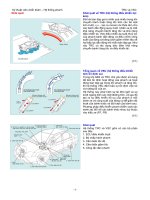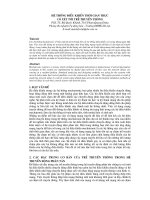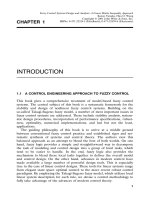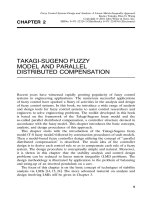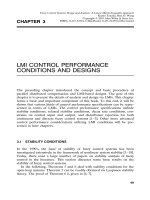Tài liệu Hệ thống điều khiển mờ - Thiết kế và phân tích P9 doc
Bạn đang xem bản rút gọn của tài liệu. Xem và tải ngay bản đầy đủ của tài liệu tại đây (560.17 KB, 41 trang )
Fuzzy Control Systems Design and Analysis: A Linear Matrix Inequality Approach
Kazuo Tanaka, Hua O. Wang
Copyright ᮊ 2001 John Wiley & Sons, Inc.
Ž. Ž .
ISBNs: 0-471-32324-1 Hardback ; 0-471-22459-6 Electronic
CHAPTER 9
FUZZY MODELING AND CONTROL
OF CHAOTIC SYSTEMS
Chaotic behavior is a seemingly random behavior of a deterministic system
that is characterized by sensitive dependence on initial conditions. Chaotic
behavior of a physical system can either be desirable or undesirable, depend-
ing on the application. It can be beneficial in many circumstances, such as
enhanced mixing of chemical reactants. Chaos can, on the other hand, entail
large-amplitude motions and oscillations that might lead to system failure.
wx
The OGY method 1, 2 for controlling chaos sparked a great number of
schemes on controlling chaos in linear andror nonlinear control frameworks
Ž wx wx.
e.g.. 3 ᎐ 9.In this chapter we explore the interaction between fuzzy
control systems and chaos. First, we show that fuzzy modeling techniques can
be used to model chaotic dynamical systems, which also implies that fuzzy
systems can be chaotic. This is not surprising given the fact that fuzzy systems
are essentially nonlinear. On the subject of controlling chaos, this chapter
wxwx
presents a unified approach 10 ᎐ 14 using the LMI-based fuzzy control
system design.
Up to this point of the book, we have mostly considered the regulation
problem in control systems. Regulation is no doubt one of the most impor-
tant problems in control engineering. For chaotic systems, however, there are
a number of interesting nonstandard control problems. In this chapter, we
develop a unified approach to address some of these problems, including
Ž.
stabilization, synchronization, and chaotic model following control CMFC
Ž.
for chaotic systems. A cancellation technique CT is presented as a main
result for stabilization. The CT also plays an important role in synchroniza-
tion and chaotic model following control. Two cases are considered in
synchronization. The first one deals with the feasible case of the cancellation
153
FUZZY MODELING AND CONTROL OF CHAOTIC SYSTEMS
154
problem. The other one addresses the infeasible case of the cancellation
problem. Furthermore, the chaotic model following control problem, which is
more difficult than the synchronization problem, is discussed using the CT.
One of the most important aspects is that the approach described here can
be applied not only to stabilization and synchronization but also to the
CMFC in the same control framework. That is, it is a unified approach to
controlling chaos. In fact, the stabilization and the synchronization discussed
here can be regarded as a special case of CMFC. Simulation results show the
utility of the unified design approach. This chapter deals with the common B
matrix case. Some extended results including the different B matrix case will
be given in Chapter 11.
9.1 FUZZY MODELING OF CHAOTIC SYSTEMS
To utilize the LMI-based fuzzy system design techniques, we start with
representing chaotic systems using T-S fuzzy models. In this regard, the
techniques described in Chapter 2 are employed to construct fuzzy models
for chaotic systems. In the following, a number of typical chaotic systems with
the control input term added are represented in the T-S modeling frame-
work.
Lorenz’s Equation with Input Term
xtsyax t q ax t q ut,
Ž. Ž. Ž. Ž.
˙
112
xts cx t y xty xtxt,
Ž. Ž. Ž. Ž. Ž.
˙
21213
xts xtxty bx t ,
Ž. Ž. Ž. Ž.
˙
312 3
Ž.
where a, b, and c are constants and ut is the input term. Assume that
Ž. wx
xtgyddand d ) 0. Then, we can have the following fuzzy model
1
Ž. wx
which exactly represents the nonlinear equation under xtgydd:
1
Rule 1
Ž.
IF xtis M ,
11
Ž. Ž. Ž.
THEN x t s Axt q But.
˙
1
Rule 2
Ž.
IF xtis M ,
12
Ž. Ž. Ž.
THEN x t s Axt q But.
˙
2
FUZZY MODELING OF CHAOTIC SYSTEMS
155
Ž. w Ž. Ž. Ž.x
T
Here, x t s xt xt xt ,
12 3
yaa0 yaa0
A s , A s .
c y1 ydcy1 d
12
0 d yb 0 yd yb
1
B s
0
0
1 xt 1 xt
Ž. Ž.
11
Mxt s 1 q , Mxt s 1 y .
Ž. Ž.
Ž. Ž.
11 21
ž/ ž/
2 d 2 d
In this chapter, a s 10, b s 8r3, c s 28 and d s 30.
Rossler’s Equation with Input Term
xtsyxty xt,
Ž. Ž. Ž.
˙
123
xts xtq ax t ,
Ž. Ž. Ž.
˙
21 2
xts bx t y c y xt xtq ut,
Ä4
Ž. Ž. Ž. Ž. Ž.
˙
31 13
Ž. wx
where a, b, and c are constants. Assume that xtg c y dcq d and
1
d ) 0. Then, we obtain the following fuzzy model which exactly represents
Ž. wx
the nonlinear equation under xtg c y dcq d :
1
Rule 1
Ž.
IF xtis M ,
11
Ž. Ž. Ž.
THEN x t s Axt q But.
˙
1
Rule 2
Ž.
IF xtis M ,
12
Ž. Ž. Ž.
THEN x t s Axt q But.
˙
2
Ž. w Ž. Ž. Ž.x
T
Here, x t s xt xt xt .
12 3
FUZZY MODELING AND CONTROL OF CHAOTIC SYSTEMS
156
0 y1 y10y1 y1
A s , A s
1 a 01a 0
12
b 0 ydb0 d
0
B s .
0
1
1 c y xt 1 c y xt
Ž. Ž.
11
Mxt s 1 q , Mxt s 1 y .
Ž. Ž.
Ž. Ž.
11 21
ž/ ž/
2 d 2 d
In this chapter, a s 0.34, b s 0.4, and d s 10.
Duffing Forced-Oscillation Model
xts xt
Ž. Ž.
˙
12
xtsyx
3
t y 0.1xtq 12cos t q ut
Ž. Ž. Ž. Ž. Ž.
˙
21 2
Ž. wx
Assume that xtgyddand d ) 0. Then we can have the following
1
fuzzy model as well:
Rule 1
Ž.
IF xtis M ,
11
Ž. Ž. Ž.
THEN x t s Axt q Bu* t .
˙
1
Rule 2
Ž.
IF xtis M ,
12
Ž. Ž. Ž.
THEN x t s Axt q Bu* t .
˙
2
Ž. w Ž. Ž.x
T
Ž. Ž. Ž.
Here, x t s xt xt and u* t s ut q 12 cos t ,
12
01
01
A s , A s ,
12
2
0 y0.1
yd y0.1
0
B s ,
1
x
2
tx
2
t
Ž. Ž.
11
Mxt s 1 y , Mxt s .
Ž. Ž.
Ž. Ž.
11 21
22
dd
In this chapter, d s 50 in this model.
FUZZY MODELING OF CHAOTIC SYSTEMS
157
Henon Mapping Model
xtq 1 syx
2
t q 0.3xtq 1.4 q ut,
Ž . Ž. Ž. Ž.
112
xtq 1 s xt.
Ž.Ž.
21
Ž. wx
Assume that xtgyddand d ) 0. The following equivalent fuzzy
1
model can be constructed as well:
Rule 1
Ž.
IF xtis M ,
11
Ž . Ž. Ž.
THEN x t q 1 s Axt q Bu* t .
1
Rule 2
Ž.
IF xtis M ,
12
Ž . Ž. Ž.
THEN x t q 1 s Axt q Bu* t .
2
Ž. w Ž. Ž.x
T
Ž. Ž.
Here, x t s xt xt and u* t s ut q 1.4,
12
d 0.3 yd 0.3
A s , A s ,
12
10 10
1
B s ,
0
1 xt 1 xt
Ž. Ž.
11
Mxt s 1 y , Mxt s 1 q .
Ž. Ž.
Ž. Ž.
11 21
ž/ ž/
2 d 2 d
In this chapter, d s 30 in this model.
In all cases above, the fuzzy models exactly represent the original systems.
As mentioned in Remark 5, the Takagi-Sugeno fuzzy model is a universal
approximator for nonlinear dynamical systems. Other chaotic systems can be
approximated by the Takagi-Sugeno fuzzy models.
The fuzzy models above have the common B matrix in the consequent
Ž.
parts and xtin the premise parts. In this chapter, all the fuzzy models are
1
Ž.
assumed to be the common B matrix case, that is, the fuzzy model 9.1 is
considered. The different B matrix case will be discussed in Chapter 11. That
is, Chapter 11 deals with the more general setting.
Plant Rule i
Ž. Ž.
IF ztis M and иии and ztis M ,
1i1 pip
Ž. Ž. Ž.
THEN sx t s Axt q Bu t , i s 1,2,...,r,9.1
Ž.
i
FUZZY MODELING AND CONTROL OF CHAOTIC SYSTEMS
158
Ž. Ž. Ž .
where p s 1 and zts xt. Equation 9.1 is represented by the defuzzifi-
11
cation form
r
w z t Ax t q Bu t
Ä4
Ž. Ž. Ž.
Ž.
Ý
ii
i
s1
sx t s
Ž.
r
w z t
Ž.
Ž.
Ý
i
i
s1
r
s h z t Ax t q Bu t ,9.2
Ä4
Ž. Ž. Ž. Ž .
Ž.
Ý
ii
i
s1
Ž. Ž. Ž .
where sx t denote x t and x t q 1 for CFS and DFS, respectively. In the
˙
Ž. Ž. Ž.
fuzzy models above for chaotic systems, z t s zts xt.
11
Remark 27 The fuzzy models above have a single input. We can also
consider the multi-input case. For instance, we may consider Lorenz
X
s
equation with multi-inputs:
xtsyax t q ax t q ut,
Ž. Ž. Ž. Ž.
˙
1121
xts cx t y xty xtxtq ut,
Ž. Ž. Ž. Ž. Ž. Ž.
˙
212132
xts xtxty bx t q ut.
Ž. Ž. Ž. Ž. Ž.
˙
312 3 3
As before, we can derive the following fuzzy model to exactly represent the
Ž. wx
nonlinear equation under xtgydd:
1
Rule 1
Ž.
IF xtis M ,
11
Ž. Ž. Ž.
THEN x t s Axt q But,
˙
1
Ž.
9.3
Rule 2
Ž.
IF xtis M ,
12
Ž. Ž. Ž.
THEN x t s Axt q But,
˙
2
Ž. w Ž. Ž. Ž.x
T
Ž. w Ž. Ž. Ž.x
T
where u t s ut u t ut and x t s xt xt xt ,
123 123
yaa0 yaa0
A s , A s ,
c y1 ydcy1 d
12
0 d yb 0 yd yb
100
B s ,
010
001
STABILIZATION
159
1 xt 1 xt
Ž. Ž.
11
Mxt s 1 q , Mxt s 1 y .
Ž. Ž.
Ž. Ž.
11 21
ž/ ž/
2 d 2 d
This fuzzy model with three inputs is used as a design example later in this
chapter.
9.2 STABILIZATION
Ž.
Two techniques for the stabilization of chaotic systems or nonlinear systems
are presented in this section. We first consider the common B stabilization
problem followed by a so-called cancellation technique. In particular, the
cancellation technique plays an important role in synchronization and chaotic
model following control, which are presented in Sections 9.3 and 9.4, respec-
tively.
9.2.1 Stabilization via Parallel Distributed Compensation
Ž.
Equation 9.4 shows the PDC controller for the fuzzy models given in
Section 9.1:
Rule 1
Ž.
IF xtis M ,
11
Ž. Ž. Ž .
THEN u t syFxt . 9.4
1
Rule 2
Ž.
IF xtis M ,
12
Ž. Ž.
THEN u t syFxt .
2
Note that the chaotic systems under consideration in the previous section are
Ž.
represented coincidentally by simple T-S fuzzy models with two rules.
Therefore the following PDC fuzzy controller also has only two rules:
2
w z t Fx t
Ž. Ž.
Ž.
Ý
ii
2
is1
u t sy sy h z t Fx t .9.5
Ž. Ž. Ž. Ž .
Ž.
Ý
ii
2
is1
w z t
Ž.
Ž.
Ý
i
i
s1
Ž. Ž.
By substituting 9.5 into 9.2 , we have
r
sx t s h z t A y BF x t ,9.6
Ž. Ž.Ž . Ž. Ž .
Ž.
Ý
iii
i
s1
FUZZY MODELING AND CONTROL OF CHAOTIC SYSTEMS
160
where r s 2. We recall stable and decay rate fuzzy controller designs for CFS
and DFS cases, where the following conditions are simplified due to the
common B matrix case. These design conditions are all given for the general
T-S model with r number of rules.
Ž.
Stable Fuzzy Controller Design: CFS Find X ) 0 and M i s 1,...,r
i
satisfying
yXA
T
y AXq M
T
B
T
q BM ) 0,
ii i i
where X s P
y1
and M s FX.
ii
Ž.
Stable Fuzzy Controller Design: DFS Find X ) 0 and M i s 1,...,r
i
satisfying
TTT
XXAy MB
ii
) 0,
AXy BM X
ii
where X s P
y1
and M s FX.
ii
Decay Rate Fuzzy Controller Design: CFS
maximize
␣
X
, M ,..., M
1
r
subject to X ) 0,
yXA
T
y AXq M
T
B
T
q BM y 2
␣
X ) 0,
ii i i
where
␣
) 0, X s P
y1
and M s FX.
ii
Decay Rate Fuzzy Controller Design: DFS
minimize

X
, M ,..., M
1
r
subject to X ) 0,
TTT

XXAy MB
ii
) 0,
AXy BM X
ii
where X s P
y1
and M s FX. It should be noted that 0 F

- 1.
ii
Example 10 Let us consider the fuzzy model for Lorenz’s equation with
the input term. The stable fuzzy controller design for the CFS is feasible.
Figure 9.1 shows the control result, where the control input is added at
t ) 10 sec. It can be seen that the designed fuzzy controller stabilizes the
Ž. Ž. Ž.
chaotic system, that is, x 0 ™ 0, x 0 ™ 0, and x 0 ™ 0.
12 3
STABILIZATION
161
Ž.
Fig. 9.1 Control result Example 10 .
Ž.
Fig. 9.2 Control result Example 11 .
Example 11 We design a stable fuzzy controller for Rossler’s equation with
the input as well. The stable fuzzy controller design for the CFS is feasible.
Figure 9.2 shows the control result, where the control input is added at
t ) 70 sec. It can be seen that the designed fuzzy controller stabilizes the
chaotic system.
FUZZY MODELING AND CONTROL OF CHAOTIC SYSTEMS
162
Example 12 We design a stable fuzzy controller for Duffing forced oscilla-
tion with the input. The stable fuzzy controller design for the CFS is feasible.
Figure 9.3 shows the control result, where the control input is added at
t ) 30 sec. The designed fuzzy controller stabilizes the chaotic system.
Ž.
Fig. 9.3 Control result Example 12 .
Ž.
Fig. 9.4 Control result Example 13 .
STABILIZATION
163
Example 13 Let us consider the fuzzy model for the Henon mapping model.
The stable fuzzy controller design for the DFS is feasible. Figure 9.4 shows
the control result, where the control input is added at t ) 20 sec.
Example 14 Consider the fuzzy model for Lorenz’s equation with the input
term. The decay rate fuzzy controller design for the CFS is feasible. Figure
9.5 shows the control result, where the control input is added at t ) 10 sec.
Note that the speed of response of the decay rate fuzzy controller is better
than that of the stable fuzzy controller in Example 10.
Example 15 Consider the fuzzy model for Lorenz’s equation with the input
term. The fuzzy controller design satisfying the stability conditions and the
constraint on the output for the CFS is feasible, where
s 9 and C s C s
1
wx Ž.
C s 1 0 0 . This means that xt is selected as the output, that is,
21
Ž. Ž. Ž.
yt s xts Cx t . Figure 9.6 shows the control result, where the control
1
input is added at t ) 10 sec. Note that the fuzzy controller satisfies
5 Ž.5
max xt F
, but the control effort is very large.
t 1
Example 16 To solve the excessive control effort problem, the constraint on
the control input is added to the design of Example 15. The fuzzy controller
design satisfying the stability conditions and the constraints on the output
and the control input for the CFS is feasible, where
s 9,
s 500, and
wx
C s C s C s 1 0 0 . Figure 9.7 shows the control result, where the con-
12
trol input is added at t ) 10 sec. The designed fuzzy controller stabilizes the
chaotic system. It should be emphasized that the control input and output
5 Ž.55Ž.5
satisfy the constraints, that is, max ut F
and max xt F
.
22
tt1
Ž.
Fig. 9.5 Control result Example 14 .
FUZZY MODELING AND CONTROL OF CHAOTIC SYSTEMS
164
Ž.
Fig. 9.6 Control result Example 15 .
Ž.
Fig. 9.7 Control result Example 16 .
STABILIZATION
165
Ž.
Fig. 9.8 Control result Example 17 .
Example 17 Consider Lorenz’s equation with three inputs described in
Remark 27. The fuzzy controller design satisfying the stability condition and
the constraints on the output and the control input for the CFS is feasible,
wx
where
s 9,
s 500, and C s C s C s 1 0 0 . Figure 9.8 shows the
12
control result, where the control input is added at t ) 10 sec. Note that the
5 Ž.5
control input and output also satisfy the constraints, that is, max u t F
2
t
5 Ž.5
and max xt F
.
2
t 1
9.2.2 Cancellation Technique
Ž.
This subsection discusses a cancellation technique CT . This approach
attempts to cancel the nonlinearity of a chaotic system via a PDC controller.
If this problem is feasible, the resulting controller can be considered as a
solution to the so-called global linearization and the feedback linearization
problems. The conditions for realizing the cancellation via the PDC are given
in the following theorem.
Ž.
THEOREM 31 Chaotic systems represented by the fuzzy system 9.2 are
Ž.
exactly linearized ®ia the fuzzy controller 9.5 if there exist the feedback gains F
i
FUZZY MODELING AND CONTROL OF CHAOTIC SYSTEMS
166
such that
T
A y BF y A y BF
Ä4
Ž.Ž.
11 ii
= A y BF y A y BF s 0, i s 2,3,...,r.9.7
Ä4
Ž.Ž. Ž.
11 ii
Ž. Ž.
Then, the o®erall control system is linearized as sx t s Gx t , where G s A y
1
BF s A y BF .
1 ii
Ž.
Proof. It is obvious that G s A y BF s A y BF if the condition 9.7
11ii
holds.
The conditions are applicable to both the CFS and the DFS. If B is a
y1
Ž.
nonsingular matrix, the system is exactly linearized using F s BGy A .
ii
However, the assumption that B is a nonsingular matrix is very strict. If B is
not a nonsingular matrix, the conditions of Theorem 31 can still be utilized
by the following approximation technique. That is, the equality conditions of
Theorem 31 are approximate by the following inequality conditions:
T
XAy BF y A y BF
Ä4
Ž.Ž.
11 ii
= A y BF y A y BF X -

S, i s 2,3,...,r ,
Ä4
Ž.Ž.
11 ii
where X is a positive definite matrix and S is a positive definite matrix such
T
Ž.
that SS- I. The conditions 9.7 are likely to be satisfied if the elements in

S are near zero, that is,

S f 0, in the above inequality. Using the Schur
complement, we obtain
T

SXAy BF y A y BF
Ä4
Ž.Ž.
11 ii
) 0,
A y BF y A y BF X I
Ä4
Ž.Ž.
11 ii
i s 2,3,...,r.
Define M s FX so that for X ) 0 we have F s MX
y1
. Substituting into
ii i i
the inequalities above yields
T

SAXy BM y AXy BM
Ä4
Ž.Ž.
11ii
) 0,
AXy BM y AXy BM I
Ä4
Ž.Ž.
11ii
i s 2,3,...,r.
Note that G is not always a stable matrix even if the condition of Theorem 31
holds.
From the discussion above as well as the stability conditions described in
this section, we define the following design problems using the CT:
STABILIZATION
167
Stable Fuzzy Controller Design Using the CT: CFS
minimize

X
, S, M , M ,..., M
12 r
subject to X ) 0,

) 0, S ) 0,
IS
) 0,
SI
yAXq BM y XA
T
q M
T
B
T
) 0, i s 1,2,...,r ,
iiii
T
Ä4
Ž.Ž.

SAXy BM y AXy BM
11
ii
) 0,
Ä4
Ž.Ž.
AXy BM y AXy BM I
11
ii
i s 2,3,...,r .
where X s P
y1
and M s FX.
ii
Stable Fuzzy Controller Design Using the CT: DFS
minimize

X
, S, M , M ,..., M
12
r
subject to X ) 0,

) 0, S ) 0,
IS
) 0,
SI
TT
XXAy MB
ii
) 0, i s 1,2,...,r ,
AXy BM X
ii
T
Ä4
Ž.Ž.

SAXy BM y AXy BM
11
ii
) 0,
Ä4
Ž.Ž.
AXy BM y AXy BM I
11
ii
i s 2,3,...,r ,
where X s P
y1
and M s FX.
ii
Decay Rate Fuzzy Controller Design Using the CT: CFS
maximize
␣
X
, S, M , M ,..., M
12
r
minimize

X
, S, M , M ,..., M
12
r
subject to X ) 0,

) 0,
␣
) 0, S ) 0,
FUZZY MODELING AND CONTROL OF CHAOTIC SYSTEMS
168
IS
) 0,
SI
yAXq BM y XA
T
q M
T
B
T
y 2
␣
X ) 0, i s 1,2,...,r ,
iiii
T
Ä4
Ž.Ž.

SAXy BM y AXy BM
11
ii
) 0,
Ä4
Ž.Ž.
AXy BM y AXy BM I
11
ii
i s 2,3,...,r ,
where X s P
y1
and M s FX.
ii
Decay Rate Fuzzy Controller Design Using the CT: DFS
minimize
␣
X
, S, M , M ,..., M
12
r
minimize

X
, S, M , M ,..., M
12
r
subject to X ) 0,

) 0, 0 F
␣
- 1, S ) 0,
IS
) 0,
SI
TT
␣
XXAy MB
ii
) 0, i s 1,2,...,r ,
AXy BM X
ii
T
Ä4
Ž.Ž.

SAXy BM y AXy BM
11
ii
) 0,
Ä4
Ž.Ž.
AXy BM y AXy BM I
11
ii
i s 2,3,...,r ,
where X s P
y1
and M s FX.
ii
Remark 28 In the LMIs above, if the elements in

и S are near zero, that
is,

и S f 0, the CT problems are feasible. In this case, G s A y BF for all
ii
i and G is a stable matrix.
Remark 29 The decay rate design problems have two parameters
␣
and

to be maximized or minimized. These problems can be solved as follows: For
instance, first minimize

, where
␣
s 0. After

is fixed,
␣
can be mini-
mized or maximized. This procedure may be repeated to obtain a tighter
solution. Another way is to introduce an idea for mixing
␣
and

as shown
in Theorems 28 and 29.
Of course, other LMI conditions, for example, the constraints on control
input and output, can be added to the design problem. Thus, by combining a
variety of control performances represented by LMIs, we can realize multi-
objective control. Chapter 13 will present multiobjective control based on
dynamic output feedback.
